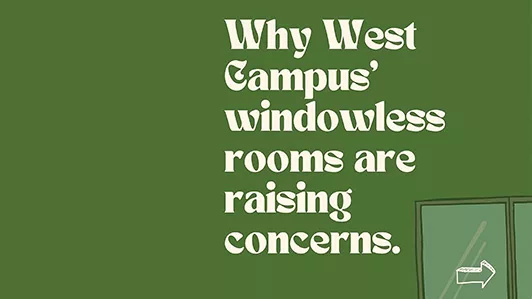
Windowless bedrooms are illegal. Right?
The issue is apparently not so cut-and-dry, much to the dismay of thousands of university students living in downtown Austin. Due to certain loopholes found in the 2021 International Building Code, the code that the City of Austin follows, so-called “luxury” student apartments can legally exclude windows from their apartment bedrooms.
As per the Code, a room must have access to “natural light or artificial light.”1
According to The Daily Texan, many popular student apartments, including Villas on Rio, Legacy on Rio, and Ion Apartments, have up to 50 percent of their rooms with no windows.2
Other apartment complexes that include windowless bedrooms are 21 Rio, Waterloo Tower, Torre Student Living, and Rambler Apartments. Coincidentally, all of these apartments promise “high end” features and “resort” like amenities.
“Not having a window in my bedroom made me feel isolated,” said Antonio Gonzalez, a UT computer science major. “It really messed with my mood and sleeping patterns,” he said. “My internal clock is much better now that I have natural light coming in through in the morning.”
Gonzalez, who is also a former military veteran, was living at Torre Student Living along with five other roommates. His room was the only one without a window.
Many students often seek advice on the r/UTAustin subreddit about whether or not windowless living is worth it. “Would you live in a windowless room on West Campus for an entire year?” asked an unnamed student. Yasmin, a biology student at UT, responded: “I’ll just say that I signed a one-year lease for a small windowless room during fall 2021-spring 2022, and now I am on anti-depressants.”
“It’s an unspoken term of the lease agreement that you also become vitamin D deficient,” Yasmin joked when I reached out for further comment. She was living at the Legacy on Rio.
Despite many students finding humor in the situation, District 9 Austin City Councilmember Zohaib “Zo” Qadri finds the issue no laughing matter. Qadri, who represents the West Campus area, sponsored a resolution to begin the process of closing the loopholes that allow the construction of windowless units. The Austin City Council approved the resolution this past September, and Qadri is making sure the proper steps are being taken to ensure these codes are changed.
However, the process will not happen overnight, Qadri told CBS Austin.3 Since 2004, the city has taken major steps to turn the West Campus area into a “high-density” neighborhood by approving zoning changes. Since then, multiple old buildings and businesses have been demolished in favor of these new high-rise apartment buildings.
One of the most recent examples of this was the relocation of an old Austin staple in West Campus, the bar Cain and Abel’s. The bar, which has now been relocated two blocks down from the original, is set to be replaced with a 30-story student housing building that is currently being constructed.
The issue of windowless apartments seems to have appeared since these efforts to redevelop West Campus began. Many professionals and organizations have been outspoken about their disapproval. Juan Miró, a UT professor who wrote an article about the trend of windowless apartments in the West Campus area in Texas Architect Magazine, finds the issue embarrassing to the community, calling it “poor architecture.”4
“This essay is an effort to rally support from architects,” Miró wrote. “For many of us, it is mind-boggling that we are even having this debate in Austin today. It is a non-issue in most large cities where windowless rooms were banned, in some cases, more than 100 years ago.”
This rising trend of windowless bedrooms in the West Campus area has garnered national attention from the architectural community, with stories about the area being highlighted in Architectural Digest5 and The Architect’s Newspaper.6
Miró also highlighted the mental health crisis that has arisen among college students that has only gotten worse since the rise of windowless apartments.
“Living in a windowless room negatively impacted my mental health,” said UT student Gustavo Meza. “It made it difficult for me to start my day, and I eventually had to buy and program a smart lightbulb to turn on along with my alarm clock. That made the situation a bit better.”
Meza, who is an engineering student at the Cockrell School of Engineering, continued that despite the cheaper cost, he did not recommend that anyone live in a windowless bedroom.
In an effort to make students more aware of the negative effects of windowless living, UT student Kayla Quilantang has created the Windowless Bedroom Initiative as president of the Undergraduate Architecture Student Council.
Quilantang informed me that she actually wrote a letter to Councilmember Qadri, encouraged by Miró. Within two weeks, the resolution was passed.
Her windowless bedroom initiative also sent the councilmember a petition, which garnered 800 signatures from students, parents, alumni, and professors in just three days.
Quilantang also used social media as a way to maximize outreach, posting her petition to @utforhousingtransparency, an Instagram page dedicated to “improving accessibility of housing information for fellow Longhorns.”
“Higher density apartments started advertising rooms with windows as ‘premiums and upgrades,” Quilantang said. “But a window is human right.”
With the resolution by Councilmember Qadri underway, Quilantang says that this victory has only encouraged her and her fellow students to explore more issues.
One such issue is what to do with already-established windowless apartments once the construction of them is banned, as well as establishing administrative offices at UT for students devoted to housing issues.
She encourages pre-law students, current law students and law alumni to get involved with the issue.
“I am glad this story can reach an audience that can get involved in ways students cannot,” Quilantang said.
For more information, you can follow the @utforhousingtransparency Instagram page, as well as reach out to the UT School of Architecture.
ENDNOTES
1 2021 International Building Code (IBC): ICC Digital Codes, § 1204, paragraph 1.
2 https://thedailytexan.com/2023/09/14/austin-city-council-approves-windowless-housing-resolution-preventing-construction-of-new-windowless-bedrooms/.
3 https://cbsaustin.com/news/local/austin-city-council-beginning-process-to-end-windowless-apartment-loophole.
4 https://magazine.texasarchitects.org/2022/09/08/windowless-bedrooms-should-never-be-an-option-lets-ban-them-for-good/.
5 https://www.architecturaldigest.com/story/wait-are-windowless-bedrooms-going-to-be-a-thing.
6 https://www.archpaper.com/2022/10/windowless-dorm-rooms-proliferating-exacerbating-a-growing-student-mental-health-crisis-they-should-be-banned/.
